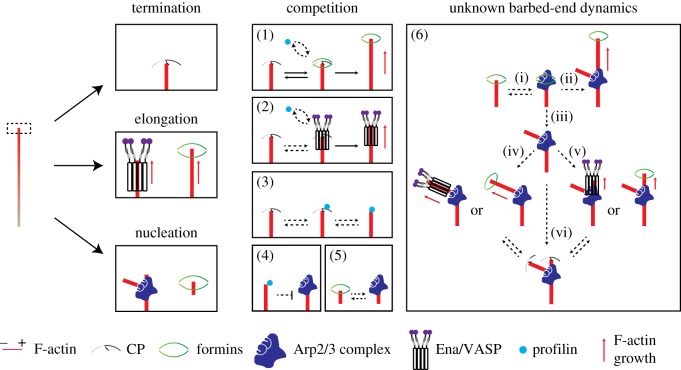Figure 2.
Open questions on the regulation of growth dynamics of actin filament barbed ends in a complex molecular process. A simplified scheme of the fate of barbed ends at the leading edge. A barbed end can be: capped and terminated for growth (termination), bound by elongation factors for enhanced growth (elongation), or bound by the Arp2/3 complex for branch formation (nucleation). Formins play a dual role in that they promote elongation, but can also lead to de novo nucleation of filaments. Several proteins compete for barbed-end binding (see main text for details): (1) capping proteins (CP) and formins, and (2) CP and Ena/VASP proteins compete for barbed ends. (3) Competition between CP-binding and anti-capping activities by formins and Ena/VASP proteins may be dependent on free profilin. Examples of open questions that await investigation in vivo: (4) Does profilin inhibit the Arp2/3 complex by binding to a barbed end? (5) Do formins and the Arp2/3 complex compete for barbed ends? (6) What is the fate of de novo nucleated filaments: (i) Do formin-polymerized filaments serve as new templates for the Arp2/3 complex? (ii) Does formin-mediated filament elongation and Arp2/3 complex branching occur simultaneously? (iii) Does the Arp2/3 complex compete with formins for barbed ends during branching? (iv) Is there a particular elongation factor (including but not limited to Ena/VASP proteins and formins) preferred for elongation of new branches? (v) What mechanisms drives elongation of the mother filament after Arp2/3 complex-mediated branching? (vi) At what rate do new branches get capped? Is there a difference in this rate between the daughter or the mother filament?

